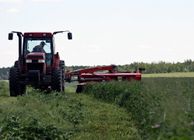4 Hay-Cutting Tips for Superior Quality

Producing high-quality hay is not a myth, and it all starts with cutting right. Equipment, timing, and technique are factors that can affect the quality of produced forage. While the best hay is one that has high sugar content, how it’s cut is just as important. Make sure everything is ready with a visit to your power equipment dealer, and follow the guide below to get started.
How to Cut & Produce Quality Hay
1. Get Your Farm Equipment Ready
Gather every essential piece of hay equipment, including disc mower, tedders, spreaders, wind mowers, and rakes, and inspect them thoroughly. Choose the right blades and sharpen them—dull ones tend to shatter leaves and stems while dragging the tractor, making it less efficient. Change blades according to recommended intervals, and stock up on replacements from your power equipment dealer.
2. Know Which Field to Cut First
 Not all fields are the same, so assess which area is good enough to cut first. Base your decision on factors like plant species, soil type, or both. Prioritize fields that have drier soil than others—wet ground often makes it difficult for hay-cutting. Cut alfalfa/orchardgrass early before it matures to get the highest nutritional feed value. A mature plant like orchardgrass will have fewer nutrients and higher fiber content.
Not all fields are the same, so assess which area is good enough to cut first. Base your decision on factors like plant species, soil type, or both. Prioritize fields that have drier soil than others—wet ground often makes it difficult for hay-cutting. Cut alfalfa/orchardgrass early before it matures to get the highest nutritional feed value. A mature plant like orchardgrass will have fewer nutrients and higher fiber content.
3. Set the Right Height
When cutting thin forage, go with a 10- or 11-degree blade to pull less dirt into the hay. Use an 18-degree blade for extra air-lift if you’re cutting thicker hay. If unsure, check your manual or consult with a trusted power equipment dealer. Make sure the cutting height is set at 1.5 to 3 inches to minimize contamination from dirt and ash. Adjust the header flotation at a height that will glide over the terrain to avoid scuffing the ground surface and wavy cutting.
4. Condition, Ted, & Windrow
Check the weather forecast first before cutting, and choose the window long enough to make hay without rain or storm. For instance, opt to cut after a cold front when temperatures have dropped by 10 to 15 degrees Fahrenheit—it’s less humid, which makes for faster drying times.
To maximize the drying surface, widely spread out the swath. If the hay is thick, use a tedder within 24 hours after cutting to spread forage over a wider field surface and boost dry-down. A conditioning system can leave gaps, even with wide swaths. Rake or lay the windrow at the widest, flattest level possible before the hay becomes too dry for baling.
Remember the above tips when cutting hay this time of the year. When you need replacement parts or repair for your farm equipment, count on Stanly Tractor Company. Headquartered in New London, NC, they’ve been the leading power equipment dealer and supplier of tractor parts from top brands like Kubota® for over 50 years. Call (704) 983-1106 today or visit them online to learn more.
About the Business
Have a question? Ask the experts!
Send your question

